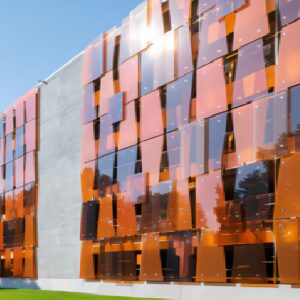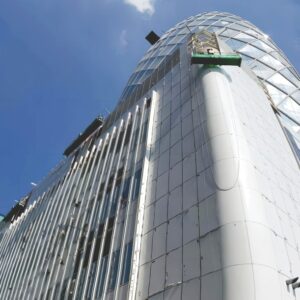I. Introduction

Alloy 6061 is a versatile and widely used aluminum alloy that offers a unique combination of strength, durability, and versatility. It is composed primarily of aluminum (95.8-98.6%), magnesium (0.8-1.2%), silicon (0.4-0.8%), and copper (0.15-0.4%). These elements contribute to the alloy’s mechanical properties, corrosion resistance, and weldability.
II. Mechanical Properties
Alloy 6061 is known for its excellent strength-to-weight ratio. It is stronger than pure aluminum, offering a yield strength of 276 MPa and an ultimate tensile strength of 310 MPa. The addition of magnesium and silicon enhances the alloy’s strength and hardness.
III. Corrosion Resistance
Alloy 6061 has good corrosion resistance in various environments, including marine and industrial applications. The presence of silicon and copper forms a protective oxide layer on the surface of the metal, which prevents further corrosion.
IV. Weldability
Alloy 6061 is highly weldable using various welding techniques, such as TIG, MIG, and plasma arc welding. The weldability of the alloy is enhanced by its low melting point (582°C) and good fluidity.
V. Applications
Alloy 6061 is widely used in a variety of applications, including:
| Industry | Applications |
|—|—|
| Transportation | Vehicle bodies, frames, and structural components |
| Construction | Windows, doors, siding, and curtain walls |
| Aerospace | Fuselage skins, wings, and aircraft parts |
| Marine | Boat hulls, decks, and superstructures |
| Consumer Products | Sporting goods, appliances, and furniture |
VI. Comparison with Other Alloys
To better understand the properties of Alloy 6061, it can be compared to other popular aluminum alloys:
| Alloy | Strength | Corrosion Resistance | Weldability |
|—|—|—|—|
| 6061 | Medium | Good | Excellent |
| 5052 | Low | Excellent | Good |
| 7075 | High | Good | Fair |
| 2024 | High | Poor | Poor |
VII. Conclusion
Alloy 6061 is a versatile and widely used aluminum alloy that offers a balance of strength, durability, corrosion resistance, and weldability. Its unique composition and properties make it an ideal choice for a wide range of applications in various industries, including transportation, construction, aerospace, marine, and consumer products.
II. Physical and Mechanical Properties

The physical and mechanical properties of a material determine its performance and suitability for various applications. These properties provide insights into its strength, flexibility, hardness, and other characteristics. Understanding these properties is crucial for engineers, designers, and manufacturers.
2. Tensile and Yield Strength
Tensile strength is a measure of a material’s ability to resist deformation and fracture under an applied tensile load, which pulls the material in opposite directions. Yield strength, on the other hand, is the stress at which a material permanently deforms under load.
Tensile strength is typically expressed in units of Pascals (Pa) or Megapascals (MPa). Yield strength is also expressed in Pa or MPa.
Table: Tensile and Yield Strength of Common Materials
| Material | Tensile Strength (MPa) | Yield Strength (MPa) |
|—|—|—|
| Aluminum 6061-T6 | 310 | 276 |
| Steel 1020 | 500 | 280 |
| Titanium 6Al-4V | 900 | 830 |
| Polycarbonate | 70 | 60 |
| Nylon | 80 | 40 |
3. Elongation and Hardness
Elongation measures the material’s ability to stretch under load before breaking. It is typically expressed as a percentage of the original length.
Hardness refers to a material’s resistance to permanent deformation from an applied load. It is measured using standardized tests such as the Rockwell, Brinell, and Vickers methods.
Table: Elongation and Hardness of Common Materials
| Material | Elongation (%) | Hardness (Rockwell) |
|—|—|—|
| Steel 1020 | 20 | 70 |
| Aluminum 6061-T6 | 12 | 60 |
| Titanium 6Al-4V | 5 | 35 |
| Polycarbonate | 50 | 10 |
| Nylon | 300 | 60 |
Significance of Physical and Mechanical Properties
The physical and mechanical properties of materials influence their performance and suitability for various applications. For instance:
- Tensile strength: High tensile strength materials are used in structural components, wires, and cables that require high load-bearing capacity.
- Yield strength: Materials with high yield strength are suitable for applications where permanent deformation is undesirable, such as gears and shafts.
- Elongation: Materials with high elongation can absorb energy without breaking, making them suitable for shock-absorbing applications.
- Hardness: Hard materials resist wear and abrasion, making them ideal for cutting tools and wear-resistant coatings.
Understanding the physical and mechanical properties of materials is essential for selecting the appropriate materials for specific applications. By considering these properties, engineers and designers can optimize performance, safety, and longevity in their products and structures.
III. Chemical Properties

Steel, an alloy of iron and carbon, exhibits remarkable chemical properties that contribute to its versatility and utility in various applications. Understanding these chemical properties is crucial for optimizing steel’s performance in different environments and ensuring its durability.
III. Corrosion Resistance
Corrosion is a significant concern for many steel structures and components exposed to harsh environments. Corrosion occurs when steel reacts with oxygen and moisture, leading to the formation of rust. The corrosion resistance of steel is influenced by several factors, including:
- Chromium Content: Chromium forms a protective oxide layer on the surface of steel, enhancing its corrosion resistance. Higher chromium content results in improved corrosion resistance, making it suitable for applications such as stainless steel cookware and automotive parts.
- Alloying Elements: Other alloying elements, such as copper, nickel, and molybdenum, can further enhance steel’s corrosion resistance by forming additional protective layers or inhibiting the corrosion process.
- Coating and Surface Treatment: Applying protective coatings, such as paint, galvanization, or anodizing, can create a barrier between the steel and the environment, improving its corrosion resistance.
IV. Susceptibility to Heat Treatment
Heat treatment is a crucial process that transforms the microstructure and properties of steel. Different types of heat treatments are employed to modify the steel’s hardness, toughness, strength, and other characteristics.
- Annealing: Annealing involves heating the steel to a specific temperature and then slowly cooling it. This process softens the steel, making it more ductile and less brittle. Annealing is used to relieve internal stresses, improve machinability, and enhance formability.
- Normalizing: Normalizing is similar to annealing but involves cooling the steel at a faster rate. This results in a finer grain structure, increased strength and hardness, while maintaining a good level of toughness.
- Hardening: Hardening involves heating the steel to a critical temperature and rapidly cooling it through a process called quenching. This produces a martensitic microstructure, which imparts high hardness and wear resistance, but also reduces toughness.
- Tempering: Tempering is a secondary heat treatment performed after hardening. It involves heating the hardened steel to a lower temperature and then slowly cooling it. Tempering reduces the brittleness of the hardened steel while maintaining a high level of hardness.
The susceptibility of steel to heat treatment depends on its composition and microstructure. Steels with higher carbon content are more susceptible to heat treatment and can achieve greater hardness and strength through these processes.
Table Comparing Corrosion Resistance and Heat Treatment Susceptibility
| Property | High Corrosion Resistance | Low Corrosion Resistance | High Heat Treatment Susceptibility | Low Heat Treatment Susceptibility |
|—|—|—|—|
| Chromium Content | >12% | <12% | High | Low |
| Alloying Elements | Copper, Nickel, Molybdenum | None | High | Low |
| Coatings and Surface Treatments | Protective Coatings | Bare Steel | Low | High |
| Carbon Content | Low | High | High | Low |
Note: This table represents general trends, and specific alloy compositions and processing conditions can influence these properties.
IV. Applications

Introduction
Metal composites are a class of materials that combine the properties of metals and other materials, such as ceramics, polymers, or carbon fibers. This unique combination of properties makes metal composites highly desirable for use in a wide range of applications, including structural components in aerospace, automotive, and marine industries and extrusion and forging applications.
Structural Components in Aerospace, Automotive, and Marine Industries
Aerospace Industry:
Metal composites are used in aircraft structures due to their high strength-to-weight ratio, making them ideal for components such as airframes, wings, and fuselage panels. The low density of metal composites reduces the overall weight of the aircraft, improving fuel efficiency and performance.
Automotive Industry:
In the automotive industry, metal composites are employed in vehicle frames, chassis components, and engine blocks. These materials offer increased strength and stiffness compared to traditional materials like steel, reducing vehicle weight and improving safety and handling.
Marine Industry:
Metal composites are utilized in marine applications due to their resistance to corrosion and fatigue. They are used in components such as ship hulls, propellers, and rudders, enhancing durability and reducing maintenance requirements.
Extrusion and Forging Applications
Extrusion:
Metal composites can be extruded into various shapes and profiles, making them suitable for applications where complex geometries are required. The enhanced strength of metal composites allows for thinner and lighter extrusions, while maintaining structural integrity.
Forging:
Metal composites can also be forged into intricate shapes. The addition of reinforcing fibers or particles improves the forging processability and reduces defects, resulting in high-performance forged components.
Advantages of Metal Composites
The combination of metal and other materials in metal composites offers several advantages:
| Property | Advantage |
|—|—|
| High strength-to-weight ratio | Lightweight and strong, reducing weight and improving performance. |
| Increased stiffness | Enhanced rigidity and stability, improving handling and safety. |
| Corrosion and fatigue resistance | Improved durability and reduced maintenance. |
| Excellent thermal conductivity | Efficient heat dissipation in high-temperature applications. |
| Electrical conductivity | Suitable for electrical applications while maintaining structural integrity. |
Comparison of Metal Composites
The choice of metal composite for a specific application depends on various factors, such as required strength, weight, corrosion resistance, and cost. The following table provides a brief comparison of commonly used metal composites:
| Type | Reinforcement | Properties | Applications |
|—|—|—|—|
| Aluminum Composites | Ceramic fibers, carbon fibers | High strength-to-weight ratio, corrosion resistance | Aerospace, automotive |
| Magnesium Composites | Ceramic particles, carbon fibers | Lightweight, high stiffness | Automotive, electronics |
| Titanium Composites | Ceramic fibers, carbon fibers | Exceptional strength-to-weight ratio, high-temperature resistance | Aerospace, racing |
Conclusion
Metal composites offer a unique combination of properties that make them highly versatile materials for advanced industries. Their use in structural components, extrusion, and forging applications provides significant advantages in terms of strength, weight, durability, and performance. As research and development continue, metal composites are expected to find even wider applications in the future.
V. Fabrication and Processing

8. Welding, Brazing, and Machining
Welding, brazing, and machining are essential fabrication and processing techniques used in the manufacturing of various metal components. Each technique has unique characteristics and applications.
Welding
Welding is a process that joins two or more pieces of metal permanently by melting and fusing their surfaces together. The most common welding methods include:
- Arc Welding: An electric arc is created between an electrode and the metal, melting the metal and creating a weld pool.
- MIG (Metal Inert Gas) Welding: A shielding gas protects the weld pool from oxidation, producing a clean and strong weld.
- TIG (Tungsten Inert Gas) Welding: A tungsten electrode creates an arc, and an inert gas protects the weld pool.
Brazing
Brazing is similar to welding, but it uses a lower temperature and a filler metal that melts and flows between the two pieces of metal being joined. The filler metal has a lower melting point than the base metal, allowing it to bond without melting the base metal.
Machining
Machining is a subtractive process that involves removing material from a workpiece using cutting tools. Common machining techniques include:
- Milling: A rotating cutter with multiple teeth removes material from the workpiece.
- Turning: The workpiece rotates while a stationary cutting tool removes material.
- Drilling: A drill bit rotates and removes material to create holes.
9. Anodizing and Powder Coating
Anodizing and powder coating are surface treatment processes that enhance the properties and appearance of metal components.
Anodizing
Anodizing is an electrochemical process that creates a protective oxide layer on the surface of aluminum and its alloys. The process increases the metal’s corrosion resistance, wear resistance, and paintability.
Powder Coating
Powder coating is a dry finishing process that applies a protective coating to a metal surface. Powdered paint is electrostatically charged and sprayed onto the metal, creating a uniform and durable coating. The coating improves corrosion resistance, chemical resistance, and UV stability.
Comparison of Fabrication and Processing Techniques
The following table compares the key parameters of welding, brazing, machining, anodizing, and powder coating:
| Process | Purpose | Applications | Advantages | Disadvantages |
|—|—|—|—|—|
| Welding | Permanent joining of metals | Structural components | Strong and durable | Heat-affected zone |
| Brazing | Joining dissimilar metals | Plumbing, refrigeration | Strong and corrosion-resistant | Lower strength than welding |
| Machining | Removing material from workpieces | Precision components | High accuracy | Can generate scrap |
| Anodizing | Corrosion and wear protection | Architectural components, electronics | Durable and decorative | Limited color options |
| Powder Coating | Corrosion and chemical resistance | Automotive, appliances | Uniform and durable | Environmental concerns |
Conclusion
Welding, brazing, machining, anodizing, and powder coating are essential fabrication and processing techniques used in the manufacturing industry. By understanding the unique characteristics and applications of each technique, manufacturers can select the most suitable processes for their specific requirements, ensuring the production of high-quality and durable metal components.
VI. Heat Treatment Options
Heat treatment is a fundamental process in metallurgy that involves controlling the temperature and cooling rate of a metal to modify its microstructure and mechanical properties. Among various heat treatment options, solution annealing, aging, and precipitation hardening are widely used to enhance the strength, hardness, and other characteristics of metals and alloys.
Solution Annealing
Solution annealing is a heat treatment process in which a metal or alloy is heated to a temperature above its solvus temperature, where all alloying elements dissolve into the parent phase, forming a homogeneous solid solution. The metal is then rapidly cooled (often by quenching in water or oil) to retain the dissolved elements in the solid solution at room temperature.
Purpose and Benefits:
* Homogenizes the microstructure
* Eliminates segregation
* Improves ductility and toughness
* Increases corrosion resistance
Aging
Aging is a heat treatment process that involves holding a solution-annealed metal or alloy at a specific temperature below the solvus temperature for an extended period. This allows the dissolved alloying elements to precipitate out of the solid solution and form fine, dispersed particles.
Purpose and Benefits:
* Strengthens the metal or alloy through precipitation hardening
* Improves hardness
* Increases wear resistance
Precipitation Hardening
Precipitation hardening, also known as age hardening, is a combination of solution annealing and aging processes. It involves heating a metal or alloy above its solvus temperature to dissolve all alloying elements, followed by rapid cooling and aging at a lower temperature. During aging, the dissolved alloying elements precipitate out of the solid solution, forming fine, coherent particles that strengthen the metal or alloy.
Purpose and Benefits:
* Significantly increases strength and hardness
* Improves toughness and ductility
* Enhances fatigue resistance and creep resistance
Comparison of Heat Treatment Options
The table below summarizes the key differences between solution annealing, aging, and precipitation hardening:
| Heat Treatment Option | Purpose | Benefits | Temperature Range |
|—|—|—|—|
| Solution Annealing | Homogenize microstructure | Improved ductility, toughness, and corrosion resistance | Above solvus temperature |
| Aging | Precipitate alloying elements | Increased strength, hardness, and wear resistance | Below solvus temperature |
| Precipitation Hardening | Combine solution annealing and aging | Significantly increased strength and hardness, improved toughness and ductility | Above and below solvus temperature |
Applications
Solution annealing, aging, and precipitation hardening are used in a wide range of applications, including:
- Aerospace components
- Automotive parts
- Cutting tools
- Medical implants
- Metalworking equipment
The specific heat treatment option used for a particular application depends on the desired properties and requirements of the metal or alloy.





